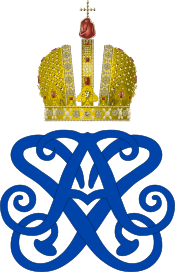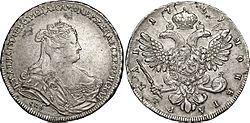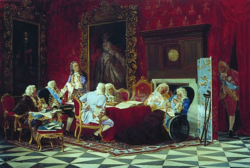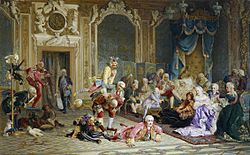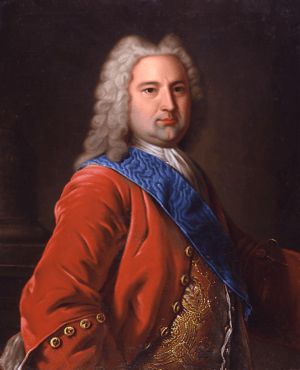Anna of Russia facts for kids
Quick facts for kids Anna |
|||||
|---|---|---|---|---|---|
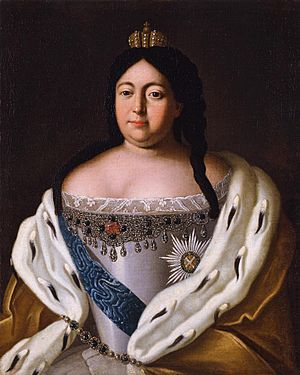 |
|||||
| Empress of Russia | |||||
| Reign | 26 (15) February 1730 – 28 (17) October 1740 | ||||
| Coronation | 28 April (9 May) 1730 | ||||
| Predecessor | Peter II | ||||
| Successor | Ivan VI | ||||
| Born | 7 February 1693 Moscow, Tsardom of Russia |
||||
| Died | 28 October 1740 (aged 47) Saint Petersburg, Saint Petersburg Governorate, Russian Empire |
||||
| Burial | Peter and Paul Cathedral | ||||
| Spouse |
Frederick William, Duke of Courland
(m. 1710; died 1711) |
||||
|
|||||
| House | Romanov | ||||
| Father | Ivan V of Russia | ||||
| Mother | Praskovia Saltykova | ||||
| Religion | Russian Orthodoxy | ||||
| Signature |  |
||||
Anna Ivanovna (Russian: Анна Иоанновна; 7 February [O.S. 28 January] 1693 – 28 October [O.S. 17 October] 1740) was a powerful leader in Russia. She first served as a ruler for the duchy of Courland from 1711 to 1730. After that, she became the Empress of Russia, ruling from 1730 to 1740.
During her time as Empress, many things happened that were started by her uncle, Peter the Great. These included big building projects in St. Petersburg and supporting the Russian Academy of Science. She also made changes that helped the noble families, like ending a law about who inherited land. In Western countries, people often saw Anna's rule as a time when Russia continued to become more like Europe, moving away from older traditions.
Contents
Anna's Early Life
Anna was born in Moscow. Her father was Tsar Ivan V, and her mother was Praskovia Saltykova. Ivan V ruled Russia alongside his younger half-brother, Peter the Great. However, Ivan V had health issues and Peter the Great was the one who truly governed the country. Ivan V passed away in 1696 when Anna was only three years old. After his death, her half-uncle, Peter the Great, became the sole ruler of Russia.
Anna was the fourth child, but only she and two of her sisters, Catherine and Praskovia, survived childhood. Their mother, a very strict and good-hearted woman, raised them carefully. She taught them to be virtuous, thrifty, and religious. Anna learned French, German, religious stories, and folk tales, along with some music and dancing. As she grew up, Anna became a strong-willed girl.
Later, her uncle Peter the Great told her family to move from Moscow to St. Petersburg. This move changed Anna's life a lot. She loved the grand events and fancy life at court, which was very different from her mother's simple lifestyle.
Ruling Courland
In 1710, Peter the Great arranged for Anna, who was 17, to marry Frederick William, Duke of Courland. He was about her age. Their wedding on November 11, 1710, was a huge celebration, just as Anna liked. Her uncle gave her a very large gift of money, 200,000 roubles.
The newly married couple stayed in Russia for a few weeks before traveling to Courland. Sadly, Duke Frederick died on January 21, 1711, just 20 miles outside St. Petersburg. The reason for his death was not clear.
After her husband passed away, Anna went to Mitau (now Jelgava), the capital of Courland (which is now part of western Latvia). She governed this area for almost 20 years, from 1711 to 1730. During this time, Count Peter Bestuzhev, a Russian official, was her main advisor. Anna never married again. She had a very close relationship with Duke Ernst Johann von Biron, a well-known person at court.
Becoming Empress
In 1730, Tsar Peter II, who was Anna's uncle Peter the Great's grandson, died young without any children. His death meant there were no more male heirs in the Romanov dynasty, which had ruled Russia for over 100 years. There were five possible people who could become the next ruler. These were the three surviving daughters of Ivan V: Catherine, Anna herself, and Praskovia. Also, the two surviving daughters of Peter the Great: Anna and Elizabeth.
Ivan V was the older brother of Peter the Great. So, his daughters might have had a stronger claim to the throne. However, if the next ruler should be the closest relative to the recently deceased Tsar Peter II, then Peter the Great's daughters were closer. This was a difficult choice because Peter the Great's daughters were born before their parents were officially married. They were later made legitimate after their mother, Catherine I, married Peter. On the other hand, Praskovia Saltykova, Ivan V's wife, came from a noble family and was known for being a good wife and mother.
In the end, the Russian Supreme Privy Council, led by Prince Dmitri Golitsyn, chose Anna to be the new Empress of Russia. They chose her over her older sister Catherine, even though Catherine was living in Russia at the time and Anna was not. There were a few reasons for this. Anna was a widow and had no children, so there was less worry about a foreign person gaining power in Russia through her. She also had experience governing, having ruled Courland for almost 20 years. Catherine, however, was married to the Duke of Mecklenburg-Schwerin. She was separated from him, which was seen as a problem. Also, Catherine had a daughter, which meant a clear line of succession that the nobles might not have wanted.
The Supreme Privy Council preferred Anna because they hoped she would feel grateful to them and let them have a lot of power. To make sure of this, the Council made Anna sign a document called "Conditions" before she became Empress. This document said that Anna had to rule according to their advice. She could not declare war, make peace, create new taxes, or spend state money without their agreement. She also couldn't punish nobles without a trial, give away land, appoint high officials, or promote anyone without the Council's permission.
Anna signed these "Conditions" in January 1730. The signing ceremony took place in Mitau, her capital in Courland. She then traveled to the Russian capital. Soon after arriving, on February 20, 1730, Empress Anna decided to get rid of the Privy Council that had set these strict "Conditions." This Council was mostly made up of the Dolgorouki and Galitzin families. Within days, another group at court, who did not like the power of these two families, asked the Empress to reject the "Conditions" and rule as an absolute monarch. Anna agreed and tore up the document. She also punished some of the people who created the "Conditions," sending many to Siberia. She then took full control and ruled as an absolute monarch, just like the rulers before her.
Anna was known for her strong will and unique sense of humor. She made Prince Mikhail Alekseevich Golitsyn her court jester and arranged for him to marry her maid, Avdotya Buzheninova. To celebrate, the Empress had an ice palace built. It was 33 feet high and 80 feet long, with icy beds, stairs, chairs, windows, and even ice logs in a fireplace. Prince Golitsyn and his bride were paraded through the streets in a cage on top of an elephant to this ice palace. They had to spend their wedding night there, even though it was a very cold winter night. Luckily, they survived. Anna also loved hunting and often kept a rifle by her window to shoot at birds whenever she wanted.
Empress of Russia's Rule
Empress Anna continued to support grand building projects in St. Petersburg. She finished a waterway that Peter the Great had started, which allowed large ships to travel. This helped expand Russia's navy. Anna's close advisor, Ernst Johann von Biron, was from Germany. Because of his influence, many people from the Baltic German region were given important government jobs. This made some of the Russian nobles feel upset.
Cadet Corps
In 1731, Anna started the Cadet Corps. This was a special group for young boys, starting at age eight, who were trained for the military. It was a very strict program that taught them everything they needed to know to hold important positions in the military. Over time, other rulers like Catherine the Great improved this program. They added arts and sciences to the cadets' studies, along with military topics.
Academy of Science
Anna continued to provide money for the Russian Academy of Science, which Peter the Great had begun. This school was created to advance science in Russia and help the country catch up with Western nations. Subjects like mathematics, astronomy, and botany were taught there. The Academy of Science also organized many expeditions. One famous example was the Bering Sea Expedition, which explored Siberia and its people while trying to find out if America and Asia were once connected.
The Academy was quite small, with never more than 12 students in the university part and just over 100 in the secondary school. Still, it was a big step forward for education in Russia. Many teachers and professors came from Germany, bringing new ideas to the students. Some of these students later became advisors or teachers to future leaders, like Catherine the Great's tutor. During Anna's reign, the Academy of Science also started including the Arts in its programs, as there was no other art school yet. Anna strongly supported the arts. Theatre, architecture, engraving, and journalism were all added to the lessons. This period also saw the beginnings of what would become the world-famous Russian Ballet.
Secret Office of Investigation
Anna brought back the Secret Office of Investigation. Its main job was to punish people found guilty of political crimes. Sometimes, it handled other types of cases too. It was rumored that Biron controlled this office, but it was actually run by Senator A. I. Ushakov. The punishments given to those found guilty were often very harsh. It is believed that around 20,000 Russians, including some high-ranking nobles, were affected by this office during Anna's rule.
Nobility
Anna gave many special rights to the noble families. In 1730, she made sure to cancel Peter the Great's law that stopped land from being divided among heirs. Starting in 1731, landowners became responsible for collecting taxes from their serfs (peasants tied to the land), which made the serfs' lives even harder. In 1736, the age for a noble to start his required service to the state changed to 20, with a service time of 25 years. Anna and her government also decided that if a noble family had more than one son, one son could stay home to manage the family estate.
Western Influences
Russia continued to adopt Western ideas and culture during Anna's reign, just as it had under Peter the Great. This was seen in places like the Academy of Science, military education (Cadet Corps), and court culture, including theatre and opera. While the changes were not as fast as under Peter, it was clear that knowledge and culture continued to grow, mostly among the nobility. Many historians believe that the German people at Anna's court played a big part in these changes.
Anna's court was different from other Russian rulers because it had many foreigners, mostly Germans. Some people think that historians have sometimes ignored Anna's rule in Russian history because of a long-standing dislike for Germans, whom Anna seemed to favor. She often gave Germans important positions in her government because she trusted them more than Russians. This strong German influence made many Russians resent them.
Foreign Affairs
During Anna's rule, Russia was involved in two main wars: the War of the Polish Succession (1733–1735) and another war against the Turks. In the Polish war, Russia worked with Austria to support Augustus II's son, Augustus, against another candidate who was supported by France and friendly with Sweden and the Ottomans. Russia's part in this war ended quickly. The Russo-Turkish War (1735–1739) was much more important.
In 1732, Russia had to give back lands in northern Persia that Peter the Great had taken. Three years later, in 1735, Russia also returned the remaining lands taken from Persia in the North and South Caucasus regions.
The war against the Turks lasted four and a half years, cost many lives, and millions of rubles. It put a lot of strain on the Russian people. In the end, Russia only gained the city of Azov and the areas around it. However, the war had bigger effects than they first seemed. Russia's military successes greatly increased its standing in Europe.
The Russians also formed a protective relationship with the leader of the Kirghiz, sending officers to help him. Two Chinese embassies visited Anna's court, first in Moscow in 1731 and then in St. Petersburg the next year. These were the only times China sent officials to Europe in the 18th century. These visits were also special because they were the only times Chinese officials showed deep respect to a foreign ruler.
Anna's Relationship with Biron
After her husband died just weeks after their wedding, Anna never remarried. As Empress of Russia, she enjoyed her power and may have felt that marriage would weaken her position. However, Anna's rule is often called "The Age of Biron" (Bironovschina), named after her close advisor, Ernst Johann Biron. Historians agree that Biron had a strong impact on Anna's decisions about Russia's internal and external affairs. Anna was drawn to Biron's charm, and he was a good companion to her. But his name became linked with harshness and fear in the public's mind. These negative ideas became a key part of how people remembered Anna's reign.
Death and Succession
As her health got worse, Anna named her grandnephew, Ivan VI, as the person who would rule after her. She also appointed Biron as the regent, meaning he would rule until Ivan VI was old enough. This was Anna's way of trying to keep the throne in her father's family line and prevent Peter the Great's descendants from becoming ruler. It was recorded that she had a kidney problem and suffered from gout. As her condition worsened, her health continued to decline.
Anna passed away on October 17, 1740, at the age of 47, from a kidney stone. Her last words were about Biron. Ivan VI was only a two-month-old baby at the time. His mother, Anna Leopoldovna, was not popular because of her German advisors and relatives. Because of this, soon after Anna's death, Elizabeth Petrovna, Peter the Great's daughter, gained the support of the people. She had Ivan VI put in a prison and sent his mother away. Anna was buried three months later, on January 15, 1741. Her death left Russia's future uncertain.
Anna's Legacy
In Western countries, Anna's time as ruler was often seen as a continuation of Russia's move from old traditions to a more European style, as Peter the Great had wanted. Her government was generally careful and helpful, but it was also very strict and eventually became unpopular. In Russia, Anna's rule is often called a "dark era." The problems with her reign came from her personality. Even though Russian rulers needed to appear strong, Anna's actions towards her people were sometimes questionable. She was known to enjoy hunting animals from her palace windows and sometimes made fun of people with disabilities. Issues like serfdom (peasants being tied to the land), high taxes, and ruling through fear continued in Russia during her time. Her empire was described as being like "a storm-threatened ship" with its crew asleep. Anna's war with Turkey, economic problems, and the events around her becoming empress all cast a shadow over her reign. She brought the court back to St. Petersburg and restored Russia's political importance to where Peter the Great had intended. The court's grandeur was almost unmatched in Europe or Asia. However, this lavish court life was overshadowed by the many people who died in war.
Images for kids
See also
 In Spanish: Ana de Rusia para niños
In Spanish: Ana de Rusia para niños
- Bibliography of Russian history (1613–1917)
- Tsars of Russia family tree


